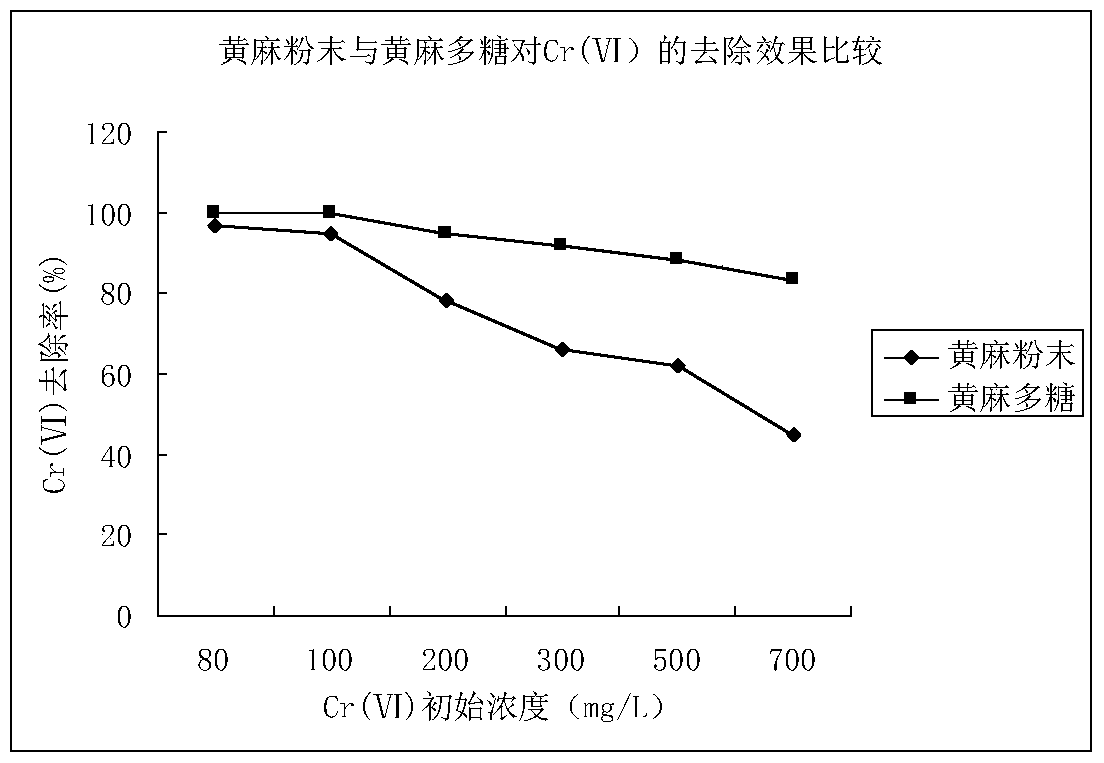Jute Polysaccharide Prepared by Steam Explosion and Its Application
A jute and polysaccharide technology, applied in other chemical processes, chemical instruments and methods, water/sludge/sewage treatment, etc., can solve problems such as difficult promotion, difficult storage and transportation of jute leaves and young shoots, and low added value. Achieve the effect of low cost, low cost and easy commercialization
- Summary
- Abstract
- Description
- Claims
- Application Information
AI Technical Summary
Problems solved by technology
Method used
Image
Examples
Embodiment 1
[0051] Embodiment 1 extracts jute polysaccharide with fresh jute tissue
[0052] (1) Harvest the leaves of long-fruited jute "Zhongjute No. 4" and the tender shoot tissue of 15cm below the stem tip before flowering, clean the fresh tissue, and crush it with a beater;
[0053] (2) Add acetic acid with a concentration of 5% to the slurry in an amount of 15% of the mass of the raw material, and stir for 60 min at room temperature;
[0054] (3) Put the above-mentioned raw materials into a high-pressure steam reactor, set the burst pressure to 1.5MPa, and hold the pressure for 8 minutes;
[0055] (4) After the steam explosion is completed, filter through the quartz sand to collect the blasting slag;
[0056] (5) 25% acetic acid is used to extract steam-exploded slag at room temperature for 1 hour, and filter to obtain the extract;
[0057] (6) Collect the precipitate: add 5% saturated cetylpyridinium chloride by volume to the leach solution obtained in step (5), collect the preci...
Embodiment 2
[0059] Embodiment 2 extracts jute polysaccharide with dried jute tissue
[0060] (1) Harvest the leaves and young shoots before the flowering of long-fruited jute. The young shoots are the stem tip tissue of about 15 cm from the top of the main stem of the plant. After the leaves and young shoots are air-dried, they are dried in an oven at 35-50°C to constant weight. ;
[0061] (2) pulverize with ultrafine pulverizer, cross 100 mesh screen sieves, obtain the jute blade and the tender arbor tissue powder (abbreviated as jute powder in the following steps) that particle diameter is 0.15mm.
[0062] (3) in the jute powder that step (2) makes, add the acetic acid of concentration 5%, the quality of addition and raw material (jute powder) is equal, stirs 60min under normal temperature;
[0063] The remaining steps are the same as those in Example 1, and will not be repeated here.
Embodiment 3
[0064] Embodiment 3 utilizes jute polysaccharide to remove Cr(Ⅵ) in potassium dichromate solution
[0065] (1) Get 100mL of potassium dichromate solution whose mass concentration of Cr(Ⅵ) is 200mg / L, and use HNO with a mass fraction of 60%-68% 3 and saturated NaOH to adjust the pH to 5;
[0066] (2) Add 1.5 g of jute polysaccharides to the sewage to be treated in (1), place on a stirrer and stir for 60 min at a speed of 150 r / min.
[0067] (3) Effect verification: 1.4 mL of the mixed solution was taken out, centrifuged (15000 r / min) for 2 min, and the supernatant was taken to measure the concentration of Cr(VI). The concentration of Cr(Ⅵ) in the solution was determined by diphenylcarbazide spectrophotometry (GB 7467-1987), and the concentration of total chromium was determined by potassium permanganate oxidation-diphenylcarbazide spectrophotometry. Each test was repeated three times, and the average of the results was taken.
[0068] The test results showed that after the j...
PUM
| Property | Measurement | Unit |
|---|---|---|
| particle diameter | aaaaa | aaaaa |
| molecular weight | aaaaa | aaaaa |
Abstract
Description
Claims
Application Information
 Login to View More
Login to View More - R&D
- Intellectual Property
- Life Sciences
- Materials
- Tech Scout
- Unparalleled Data Quality
- Higher Quality Content
- 60% Fewer Hallucinations
Browse by: Latest US Patents, China's latest patents, Technical Efficacy Thesaurus, Application Domain, Technology Topic, Popular Technical Reports.
© 2025 PatSnap. All rights reserved.Legal|Privacy policy|Modern Slavery Act Transparency Statement|Sitemap|About US| Contact US: help@patsnap.com

